Doctors of Osteopathy (DOs) receive additional training in the musculoskeletal system, focusing on the interconnectivity of the nerves, muscles, and bones. Osteopathic doctors are fully licensed physicians who can practice medicine, prescribe medicine, and perform surgery, depending on their area of practice.
At Kansas College of Osteopathic Medicine (KansasCOM), we train our osteopathic students to become competent and compassionate physicians who will apply the tenets of osteopathic medicine in their practice. Through our unique exposure to interactive learning environments, we create a comprehensive curriculum for our students to gain essential experience in identifying and treating patients’ needs.
Osteopathic Philosophy: Andrew Taylor Still, M.D.
Andrew Taylor Still is considered to be the American founder of osteopathy. He believed that disease treatment and health management can be obtained through adjusting the body, manipulative techniques, and surgical therapy.
Andrew Still crafted the four principles of osteopathy in 1874 to promote preventative medicine and encourage doctors to use a whole-person approach. Osteopathic medicine prioritizes treatment by working through manipulative therapy to correct structural problems.
What are the Tenets of Osteopathic Medicine
The four tenets of osteopathic medicine are:
- The body is a unit; the person is a unit of body, mind, and spirit
- The body is capable of self-regulation, self-healing, and health maintenance
- Structure and function are reciprocally interrelated
- Rational treatment is based upon an understanding of the basic principles of body unity, self-regulation, and the interrelationship of structure and function
These osteopathic principles emphasize the dysfunction of either the mind, body, or spirit could be reflected in the patient’s mental, physical, or environmental state. The body can heal itself naturally rather than relying on prescription drugs to treat individual symptoms, not the root cause of the dysfunction. Osteopathic doctors must diagnose and treat patients following these tenets for the optimal impact on health care.
How to Apply the Osteopathic Tenants
Structure and Function
Osteopathic manipulative treatment (OMT) is the therapeutic application of the osteopathic tenets. After evaluating the patient’s body, mind, and spirit, the DO can determine and diagnose the body’s dysfunction hindering motion or healing.
Osteopathic doctors apply physical force or manual pressure to restore the barrier blocking the body’s natural healing and promote proper function.
Whole-Person Approach
Osteopathic principles focus on patient-centered care. Osteopathic doctors engage with patients to evaluate the mental, physical, and emotional factors that may impact their health. This includes going beyond the symptoms and looking at the patient’s lifestyle habits. In conjunction with extensive musculoskeletal function and treatment training, the whole-person and individualized approach osteopathic doctors take helps lead to optimal health.
Become an Osteopathic Doctor
Osteopathic medicine offers a unique approach to health care. When evaluating and diagnosing patients, osteopathy considers the person as a whole, including their emotional, physical, and spiritual needs and lifestyle. Understanding how the body is interconnected and can be regulated and healed without the need to prescribe medications to treat individual symptoms is what separates osteopathy from traditional medicine.
At Kansas College of Osteopathic Medicine, our hands-on curriculum trains future osteopathic doctors to embody the core tenets. Students will gain the skills to apply the osteopathic tenets in real-world practice in any field of medicine.
If you are ready to make a difference in the medical field by applying the osteopathic tenets, KansasCOM is here to help. Pursue your osteopathic career as a DO and promote wellness through a whole-person and structured approach.

